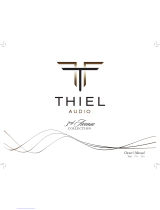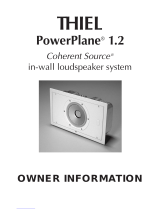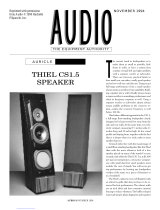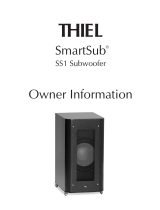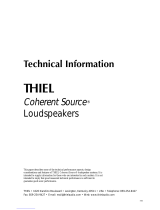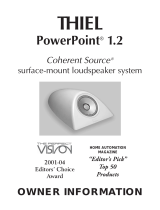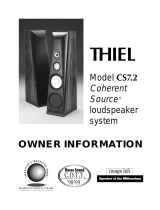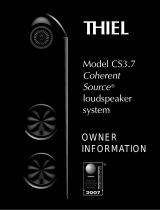Page is loading ...

March 2002
Thiel PowerPoint Surface-Mount Loudspeakers
The biggest problem most people have with home theater is
not the size of the monitors (everybody wants a bigger TV)
or even the cost (those $10,000 plasma sets are flying out of
the stores). No, the sticking point for most people is where
to put all those extra speakers.
Actually, if you watch the home-porn on HGTV or read the
nesting press like Architectural Digest, you'd be forgiven for
thinking that, if left to their own devices, designers would just
as soon ban all loudspeakers from rooms.
Now, I'm an audiophile, myself. I figure, what's the point of
having floor space, if not to have a blank surface to put
speakers on? And if Anthony Powell opined that Books Do
Furnish A Room, I feel the same way about speakers. Why
heck, the most comfortable rooms I've ever been in have
been filled with books, records, and speakers. But then, no
room I've ever lived in is in the slightest danger of appearing
on the cover of Architectural Digest.
So what do you do if you have a designer room that you want
to use for home theater—or even if your room is already so
stuffed with speakers, books, and records that you have
nowhere to put any extra speakers?
Most people rely on in-wall or on-wall loudspeakers. However,
until recently, in-wall loudspeakers were pretty much aimed
at industrial applications such as restaurants, stores, malls,
and the like. They were more about disappearing than they
were about sounding good. That's changed in the last decade
or so, but in-walls are hard to review, so that's still a pretty
well-kept secret.
On-wall speakers have lagged behind the in-walls, simply
because they aren't as sexy. You've still got something that
looks like a speaker in the room, so designers avoid 'em
like the undead shun garlic. And speaker companies sort
of treat 'em like their ugly sisters—they include 'em in the
literature, but they don't introduce 'em to all their friends.
Lying in bed would be an altogether perfect and
supreme experience if only one had a colored
pencil long enough to draw on the ceiling.
The Thiel PowerPoints are different, though. Boy, are they
different! First, Thiel is proud of 'em—in fact, Jim Thiel tells
me, strictly based on dollar amounts, they were the company's
No. 1 selling product last year.
Further, they're kind of sexy looking. They're wedge-shaped
—they look like a doorstop writ large. Mounted on a wall or
ceiling, they look more like modest bulges than like speakers
stuck on the wall. And they're paintable, so they blend in
even more than you might think—in fact, Thiel includes a
paint-mask, so you can conveniently paint the entire
PowerPoint, including the grille, without threatening the
speaker's coaxial driver.
Nor are the PowerPoints just an afterthought product,
added to the line to make it competitive. That's not the way
Jim Thiel works. One thing that has always distinguished
Thiel as a speaker line is the way it adheres to Jim's speaker-
building philosophies. There are certain features shared
by all Thiel products. Jim believes in time-aligned arrays,
which ensure that all of the drivers launch a music wave
simultaneously. He also believes that first-order crossovers,
which maintain the phase integrity of the musical signal
throughout the speaker’s entire frequency response, are
the only technically correct approach. And he thinks
that his crossovers must be constructed from the finest
components. And that speakers should be solidly built
and rigidly braced. So that's the way Jim builds all his
speakers—and to ensure that they're all as close to his idea
of perfection as possible, these days, Jim designs and
Product Review
Thiel Audio
PowerPoint Surface-Mount Loudspeakers
© Schneider Publishing Inc.
w w w. o n h o m e t h e a t e r. c o m

constructs all his own drivers in-house.
The PowerPoint features a custom-built driver based on the
coaxial driver Jim designed for his SCS3 multimedia speaker.
The 1" dome tweeter—the same one used in Thiel's
$13,500 CS7.2—is mounted coaxially with the woofer,
which is to say that it is located in the center of the woofer
cone so that its wave can launch at the same time as the
woofer's.
The tweeter uses a special magnet structure made of
neodymium magnets, which are expensive but extremely
powerful. These magnets give the speaker high output
capability and low distortion.
The 6.5" woofer uses the same two-layer diaphragm as the
SCS3. There is an aluminum layer bonded to a lightweight
cast polystyrene layer to ensure its rigidity. The cone has
a specially designed shallow flare to prevent it from acting
like a horn for the tweeter. (To get an idea why that's bad,
cup your hands around your mouth and speak—that's what
a horn does to a sound source.) However, the PowerPoint
places certain physical requirements on the driver—it needs
to keep quite close to the wall, so the SCS3's magnet
system had to be redesigned to employ higher-output
neodymium magnets in order to keep the driver's motor-
system compact.
Like all Thiel loudspeakers, the PowerPoints employ a
complex first-order network using many polypropylene and
polystyrene capacitors. "Well," Jim Thiel allows, "By our
standards, it's not really complex—it is just a two-way
design, after all. There are some small changes we had to
make because it's designed to use on a boundary, so we
had to correct for the emphasis you do get in the lower
midrange and bass regions."
Dancing on the ceiling . . .
The shell is thermo-formed 3/8"-thick plastic, heated and
vacuum-formed to its complex shape. It is rigidly braced
from the inside, so that the whole is quite inert. And small—
it's only 19.75"L x 12.25"W x 5.5"H.
And the PowerPoints cost $1300 each. That's a hefty price
tag for such a small speaker, but—packed with premium
parts, custom-built drivers and custom-built motor systems
—the PowerPoints aren't built like mass-produced products.
They're essentially cost-no-object devices built to optimize
performance in what other designers have deemed a
compromised situation.
It's obvious that Jim Thiel doesn't see it that way. "When
Kathy [Kathy Gornik, Thiel's president] said, 'We need an
on-wall.' I went, 'Ohhhhhhhh-kay,'" Thiel said. "Originally, I
just figured I'd take our coaxial driver and put it in a shallow
cabinet with the driver mounted parallel to the wall, like
all the other designs out there. I had some vague idea that
I'd taper the cabinet to the wall to minimize diffraction."
The results weren't pretty. Thiel continued, "We mocked
up something along those lines and we took the first
measurements and saw that there was a big hole in
the midrange caused by the reflection off the wall, even
though I'd tapered the cabinet into the wall. That caused
a cancellation where that distance equaled a quarter
wavelength. That cancellation created a 6dB hole smack in
the middle of the midrange and we just couldn't do that."
Then inspiration struck—instead of trying to create a speaker
that tried to compensate for its near-boundary location,
what if it exploited it? "I got the idea that, if I mounted
the driver close enough to the wall, and, if the driver was
mounted at a significant angle to the wall (in the case of the
PowerPoint, that angle is 45 degrees), at some higher
frequency the dispersion will become less than 45 degrees.
So, if you can get the driver close enough to the wall so
that the frequency that is cancelled is higher than the
frequencies that the driver can disperse at 45 degrees, then
you won't have a cancellation because the frequency
that would be cancelled is high enough that the driver is
not dispersing energy at that frequency at a wide-enough
angle to project energy against the wall.
"That was my idea—and it turned out to work really well.
The only complication in working it out was that, to get
the driver close enough to the wall, we had to build a really
shallow driver with a physically small magnet system. So
we had to use a neodymium magnet system and design
things a little differently."
Oh sure—it sounds so easy when he says it.
"Only then did we start appreciating that there's a h u g e b e n e f i t
in having the driver so close to the boundary that you
essentially have no reflection from the boundary. Also, by
having that driver at 45 degrees, there were advantages in
room coverage and dispersion of energy throughout the room.
© Schneider Publishing Inc.
2
w w w. o n h o m e t h e a t e r. c o m

3
© Schneider Publishing Inc.
"Those benefits were serendipitous—we didn't really
have them in mind going into the project and, since the
topology was developed in response to certain more
obvious considerations, it still didn't occur to us that the
design would offer these benefits. But when we listened to the
finished product we realized we had something really cool!"
Adieu tristesse / Bonjour tristesse / Tu es inscrite
dans les lignes du plafond.
(Farewell sadness / Good-day sadness / You are inscribed
in the lines of the ceiling …)
Really cool, eh? That's about right—the first time I heard my
system with five PowerPoints set up, I just kept giggling and
replaying parts of The Ghosts of Mars that sounded really
impressive. This says a lot about how well the Thiels
enveloped me with sound and not a whole heck of a lot
for the quality of the movie, which was so uncompelling, I
didn't mind interrupting it frequently.
But to be fair, I was having such a ball with the Thiels, I
probably would have done the same thing with a movie
that actually had characters I cared about. The five Thiels
created environments that were totally sonically believable.
Even though they're monopoles, and it's dipoles that are
supposed to disappear and generate sound that doesn't
seem to emanate from a specific location, the Thiels totally
disappeared.
Actually, as I went through my selection of greatest-DVD
surround-ambience hits, I came to the conclusion that I had
never heard a more immersive system in a home—
the sound rivaled the sort of envelopment I have only heard
in 42nd Street showcase cinemas.
I don't tend to revel in explosions, crashes, and giant lizard
stomps—although the Thiels do handle high-excursion
silly sound levels with great aplomb—I'm a bigger fan of
the subtle sounds that emulate real life. Stuff like the
rainfall and lightning taking place during Gene Hackman's
big quayside speech in Crimson Tide or the changes in
room acoustics as characters dash in and out of different
rooms in the Pentagon in Clear and Present Danger or the
simple sounds of the wind passing through the jungle in
the same film.
Jonathan Demme is the master of mise en scéne or the
setting up of the environment in which a film takes place.
Nowhere is this more obvious than in The Silence of the
Lambs, where every scene has the lived-in clutter and
individual touches that distinguish rooms in real life and
that movies and TV shows never get right. Places like the
autopsy lab where Clarisse discovers the Death's Head
moth or the victim's bedroom where Clarisse searches
for clues have the disarray and jumbled minutia of real
life. This attention to detail extends to the sonic landscape
of the film, and the film distinguishes between rooms with
a myriad of tiny sound cues. With the Thiels, shifts in
scene were almost dizzying, and the longer the camera
lingered in each environment, the more detail accrued. This
is precisely what surround sound is supposed to be like
and almost never is.
What the Thiels don't do is recreate deep bass. From about
75Hz to 20kHz, you couldn't ask for better response,
but below that, nada. Well, fine, that's what subwoofers are
for, but that puts the total system cost up there. I used the
Polk PSW650, which is not only quite reasonably priced at
$780, but a most effective partner to the Thiels. Rolling off
the Thiels at about 80Hz made it possible to seamlessly
blend the PowerPoints with the floor-mounted subwoofer.
When I spoke to Jim Thiel about his design process on
the PowerPoints, he almost apologetically suggested that I
listen to a pair of them as full-range speakers in a stereo
configuration. No need for apologies—they sounded fantastic!
Just as the 5.1 system was completely enveloping, the
two-channel system was practically holographic.
The men's chorus Chanticleer recently released a recording
of John Tavener's Lamentations and Praises [ Te l d e c
Classics 0927-41342-2], a specially commissioned work
for the group's 12 voices and a fascinating combination of
instruments and electronics: flute, bass trombone, string
quintet, tape, and a percussion section comprised of a
Byzantine monastery bell, Tibetan temple bowl, tam-tam,
simantron (a large wooden sounding-board struck with a
hammer), tubular bells, and timpani.
The composer describes Lamentations and Praises as a
"sequence of ikons" linked, as he explains in the score, "by
a corridor of music." Through the recording, laid down at
Skywalker Sound, the group essentially "stages" the work
by exploiting different acoustics for the various scenes and
connecting passages. The PowerPoints set me down in
the midst of the changing acoustic, cushioned in the soft
pillow of the reverberant sound of men's voices and the
shifting instrumental textures. What a fabulous experience.
w w w. o n h o m e t h e a t e r. c o m

© Schneider Publishing Inc.
In fact, as I told Jim Thiel, it was better soundstaging than
I had experienced with some very serious loudspeaker
systems. "In a way, these speakers image better than a
conventional floorstanding speaker," Jim explained,
"because you don't have any equivalent floor reflection. By
not having that boundary reflection to tell you the sound
source is a certain distance away, you are more transported
to the soundfield of the recording you're listening to." What
he said!
Talk about an acoustic ceiling . . .
The last complete home-theater speaker system I reviewed
consisted of the Polk LSi15, LSiC, LSi7, and PSW650—
a system that retails for just over $3900. A system comp r i s e d
of five Thiel PowerPoints and the Polk PSW650 retails for a
little over $7100.
Both systems were immersive and dynamic, but there were
noticeable differences between the two. The front three
Polks worked extremely well together and offered a greater
sense of slam in loud and clamorous scenes, but they
couldn't match the speaker-to-speaker timbral uniformity of
the three identical PowerPoints. Also, as good as the Polk
LSiC is, it contributes a mild "picket-fence" comb as you
pass your head from one side to the other. The wide
dispersion and identical dispersion pattern of the three front
channel PowerPoints' coaxial driver systems not only
avoids that, it almost avoids any indication of there being
three separate soundfields up front. From one wall to the
other, the sound is seamless.
The surround channels differ, as well. The Polk LSi7s are
monopoles, as are the PowerPoints, but the surround
e f fects coming from the Polks are far more speaker specific
than the same sounds from the Thiels.
Now the Polks are no different from most other monopole
speakers in this regard. While some people insist that
only dipoles deliver the properly diffuse soundfield that
movie-theater surround is known for, I've never been able to
summon any great degree of passion one way or the other
on the subject. I've heard great-sounding dipoles that
generated truly non-locatable diffuse soundfields, but I've
also known monopoles that performed just as convincingly.
The PowerPoints seemed to offer the best of both worlds,
however. While I never found the Polks unsatisfying in my
audition, I vastly preferred the atmospheric immersion the
PowerPoints were capable of. It sounded "real"-er.
As a surround system, the PowerPoint/PSW650 system
was the clear victor—albeit at nearly twice the price. Things
were on a much more equal footing when I compared the
LSi15s as a stereo pair to a stereo pair of PowerPoints. The
Thiels still had that seductive complete envelopment thang
going—I've seldom heard their equal at that trick at any
price. But the LSi15s present an amazingly seamless sonic
portrait that is difficult to fault—and sure enough, even the
coaxial PowerPoints were hard pressed to beat 'em at it.
Call it a draw.
However, the Polks had far more low end—and even lower
midrange—authority. The Thiels, like many stand-mounted
monitors, just don't have the low end to compete with Polk's
floorstanding bargains. Music has greater body and heft—
and sounds more believably anchored to this world—
with the LSi15s. And, just as with many minimonitors, the
Thiels achieve a great deal of their U-R-There holography
because they d o n ' t have to struggle with the bottom
few octaves. Some people prefer this sound to the more
r e a l i s t i c , but less detailed-sounding full-range reproduction
of a larger speaker.
On the other hand, unlike stand-mounted monitors or the
Polk LSi15, the Thiels offer that seductive sound without
occupying any valuable real estate on the floor, which
makes them all but invisible in the room. I almost said that's
something you can't buy at any price—except, of course,
you can buy it for the price of a pair of Thiel PowerPoints.
Can a muse of fire exist under a ceiling
of commerce?
The Thiel PowerPoints are speakers that were born of
necessity and—through Jim Thiel's design insights and T h i e l ' s
general construction integrity—overcame the conventional
shortcomings attributed to an entire class of loudspeakers.
That's a pretty amazing story in itself.
But they sound so good they actually turn the audio world,
ummm, upside down. Let me say this again: They almost
totally disappear once mounted to the ceiling and painted to
match it. They aren't inexpensive, but they are built to an
extremely high level. Considering that you're buying a custom-
molded enclosure with custom-built drivers and packed with
exotic electronic parts, their price doesn't seem out-of-line
at all.
4
w w w. o n h o m e t h e a t e r. c o m

5
© Schneider Publishing Inc.
And then, factor in the fact that you get all this and your
uncluttered House & Garden décor to boot. I call that a
bargain. I'm sold—maybe floors do have better uses than
holding up loudspeakers.
...Wes Phillips
w w w. o n h o m e t h e a t e r. c o m
Thiel PowerPoint Surface-Mount Loudspeakers
Price: $1300 USD each
Warranty: Ten years parts and labor.
Thiel Audio Products
1026 Nandino Boulevard Phone: (606) 254-9427
Lexington, Kentucky Fax: (606) 254-0075
40511 E-mail: [email protected]
USA Website: www.thielaudio.com
onhometheater.com is part of the SoundStage! Network
Published by:
Schneider Publishing Inc.
Box 20068, 390 Rideau Street,
Ottawa, ON K1N 9N5
Canada
/

